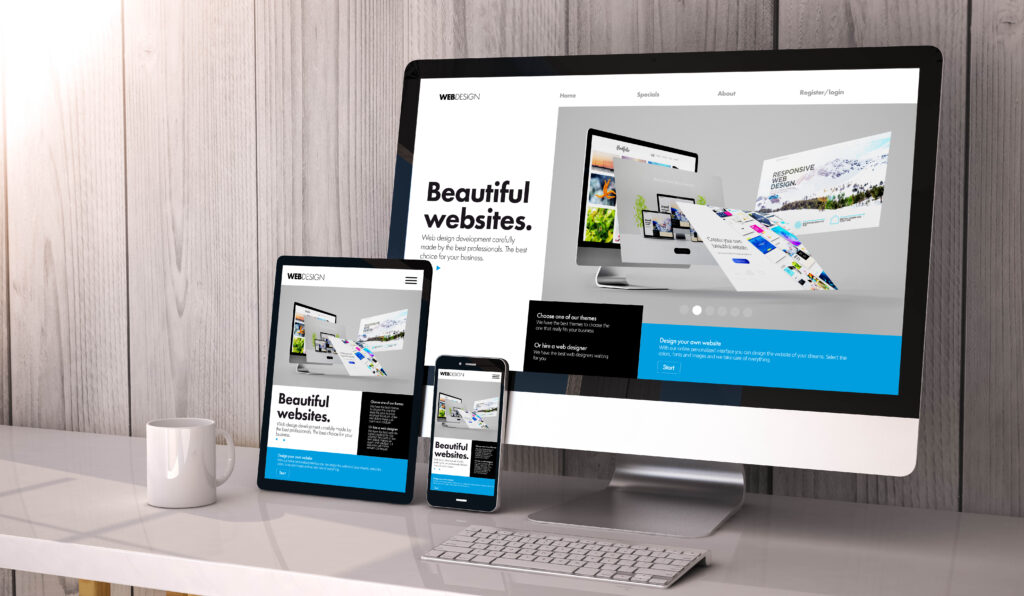Introduction to Website Creation Tools
Building an online store for your business has never been more straightforward, thanks to the rise of website creation tools. These platforms have revolutionised how businesses establish their online presence, allowing even those without extensive technical knowledge to create professional and effective websites. With a variety of features designed to streamline the process, website builders offer an accessible solution for both seasoned entrepreneurs and newcomers.
One of the primary advantages of using a Website Builder is the accessibility it provides. Traditional web development often involves coding knowledge and a significant time investment. In contrast, website builders come with pre-designed templates and drag-and-drop functionality, making the process much simpler and quicker. This means you can focus more on your business and less on the technical aspects of website creation.
Moreover, Website Builders come with integrated tools that cover various essential aspects of running an online store. From SEO optimisation to mobile responsiveness, these platforms ensure your website meets modern standards without requiring additional plugins or extensions. This holistic approach makes it easier to manage and maintain your website over time.
Another significant benefit is the cost-effectiveness of Website Builders. Traditional web development can be expensive, especially when considering ongoing maintenance and updates. Website Builders typically offer subscription plans that include hosting, domain registration, and customer support, providing a more budget-friendly option for small to medium-sized businesses. The ability to control costs without compromising on quality is a key reason why many businesses opt for these tools.
The flexibility of Website Builders also cannot be overstated. They cater to a wide range of industries, offering specialised templates and features tailored to different business needs. Whether you are running a boutique shop, a consultancy firm, or a large-scale ecommerce platform, there is likely a website builder that fits your requirements. This versatility allows you to customise your site to reflect your brand’s unique identity, helping you stand out in a crowded online marketplace.
Integration capabilities are another noteworthy feature of Website Builders. Many platforms offer seamless integration with popular third-party services and tools, such as social media platforms, email marketing services, and analytics tools. This enables you to create a cohesive digital ecosystem that supports various aspects of your business, from marketing to customer engagement and beyond.
User support is also a critical component of most Website Builders. Comprehensive customer support options, including tutorials, forums, and direct assistance, can help you navigate any challenges you might encounter. This level of support is particularly beneficial for those who are new to website creation, ensuring that help is always available when needed.
Finally, Website Builders are designed with scalability in mind. As your business grows, your website can grow with it. Many platforms offer advanced features and upgrades that allow you to expand your site’s capabilities over time. This means you won’t outgrow your website builder, providing long-term value and stability for your online presence.
Selecting the Ideal Website Creation Tool
Choosing the right Website Builder is crucial to your success online. There are several factors to consider when selecting a website creation tool. Firstly, look at the pricing. Website builders usually range from £8 to £40 per month, which often includes web hosting and domain registration. Additionally, consider the features offered, such as ease of use, available templates, and customer support.
If you’re specifically looking to build an ecommerce shopping website, it’s worth exploring popular options like Shopify and BigCommerce, which are tailored for online stores. Squarespace is another excellent choice as it features a wide variety of appealing templates.
When evaluating Website Builders, ease of use is an essential factor. A platform with intuitive navigation and user-friendly interfaces will make the building process more enjoyable and less time-consuming. Look for features such as drag-and-drop editors, which allow you to place elements on your site without any coding skills. User-friendly dashboards and clear instructions can significantly reduce the learning curve, enabling you to get your site up and running quickly.
The variety and quality of templates available are another important consideration. Templates provide a foundation for your site’s design, so having access to a diverse range of high-quality options is beneficial. Ensure that the templates offered are customisable to fit your specific needs and brand identity. This flexibility allows you to create a unique and professional-looking website that stands out from the competition.
Customer support is also a critical aspect to consider. Whether you are a beginner or an experienced user, having access to reliable customer support can save you a lot of headaches. Look for website builders that offer multiple support channels, such as live chat, email, and phone support. Additionally, resources like tutorials, FAQs, and community forums can provide valuable assistance and help you troubleshoot common issues.
Another factor to keep in mind is the integration capabilities of the Website Builder. Seamless integration with third-party services, such as social media platforms, email marketing tools, and analytics services, can enhance the functionality of your site. This allows you to create a cohesive digital ecosystem that supports your business operations, marketing efforts, and customer engagement.
Scalability is another key consideration. As your business grows, your website needs may evolve. Choose a Website Builder that offers scalable solutions, including advanced features and upgrades. This ensures that your website can grow alongside your business, providing long-term value and stability.
Lastly, take into account the website builder’s SEO features. Effective SEO tools can improve your site’s visibility in search engine results, driving more traffic to your online store.
Crafting the Design of Your Online Shop
The design of your online shop is pivotal in capturing the interest of potential customers. Most Website Builders offer an array of templates and themes, facilitating the selection of a design that resonates with your brand’s ethos. Begin by choosing a template that aligns with your business’s visual identity. Then, customise it by modifying colours, fonts, and layouts to ensure it accurately represents your brand.
Personalisation is key. Adjusting the template to include your brand’s colour scheme and typography will make your website more cohesive and professional. Additionally, consider using high-quality images and consistent branding elements across all pages to create a unified look.
User experience should be at the forefront of your design strategy. A clutter-free, intuitive layout can significantly enhance the ease with which visitors navigate your site, leading to higher engagement and conversion rates. Ensure that menus are straightforward and categories are clearly defined, enabling customers to find what they’re looking for quickly.
The use of whitespace is another important aspect of design. It prevents your site from looking overcrowded and makes the content more digestible. This clean and organised appearance can make your online store look more appealing and professional.
Interactive elements can also play a vital role in engaging your audience. Features such as image sliders, video backgrounds, and animations can make your site more dynamic and engaging. However, it’s essential to use these elements judiciously to avoid overwhelming visitors.
Responsiveness is a non-negotiable aspect of modern web design. Ensure that your online shop is mobile-friendly, as a significant portion of online shopping is conducted on mobile devices. Most website builders provide templates that are automatically optimised for mobile use, but it’s always a good idea to preview your site on different devices to ensure a seamless experience.
Accessibility is another critical consideration. Your website should be designed to be usable by as many people as possible, including those with disabilities. Features like alternative text for images, keyboard navigation, and readable fonts contribute to making your site more accessible.
Incorporating trust signals into your design can also build customer confidence. Displaying badges for secure payment methods, customer testimonials, and clear return policies can reassure visitors and encourage them to complete their purchases.
Lastly, ensure that your design allows for easy updates and modifications. As your business evolves, you may need to adjust your website to reflect new products, branding changes, or design trends. A flexible and adaptable design will save you time and effort in the long run.
By focusing on these design principles, you can create an online shop that is visually appealing, user-friendly, and reflective of your brand’s identity, providing an excellent shopping experience for your customers.
Incorporating Products and Content
Once your design is finalised, it’s essential to populate your online shop with products and engaging content. Website builders streamline the process of adding product images and descriptions, making it user-friendly for even those with minimal technical skills.
When crafting product descriptions, prioritise clarity and detail. Highlight the unique selling points and key features of each item to provide potential customers with all the information they need to make informed purchasing decisions. Employ a consistent tone and style in your descriptions to maintain a cohesive brand voice across your site.
High-quality images are vital in showcasing your products effectively. Ensure that images are clear, well-lit, and taken from multiple angles to give customers a comprehensive view of the items. Consider including zoom functionality and 360-degree views to enhance the user experience. Videos can also be a valuable addition, offering dynamic demonstrations of product features and benefits.
In addition to product listings, engaging content plays a crucial role in attracting and retaining visitors. Blog posts, tutorials, and guides related to your products can provide added value to your customers, encouraging them to spend more time on your site and explore your offerings. Content that addresses common questions or problems can establish your business as a knowledgeable and trustworthy source in your industry.
Consistency in branding is crucial when incorporating products and content. Use a uniform colour scheme, font style, and visual elements across all pages to create a professional and cohesive appearance. This consistency extends to your product images and descriptions, ensuring that each element aligns with your brand’s identity.
Metadata, such as alt text for images and meta descriptions for pages, should not be overlooked. These elements improve your website’s accessibility and enhance its search engine optimisation (SEO). Effective use of keywords in your product descriptions and other content can help improve your site’s visibility in search engine results, driving more traffic to your online store.
Interactive content, such as customer reviews and ratings, can also enhance the shopping experience. Encouraging satisfied customers to leave reviews builds trust and provides social proof for potential buyers. Displaying these reviews prominently on your product pages can increase conversion rates.
The organisation of your content is another important factor. Group similar products into categories and use filters to help customers easily find what they are looking for. A well-organised site not only improves user experience but also encourages visitors to explore more products.
Regularly updating your product listings and content is vital. Introduce new products, update descriptions for existing ones, and refresh blog posts to keep your site current and engaging. Seasonal updates and promotions can also draw in returning customers and spark interest from new visitors.
By carefully incorporating products and content, you can create a rich and engaging online shopping experience that not only attracts visitors but also encourages them to return.
Configuring Payment and Shipping Solutions
Configuring payment and shipping solutions is a critical aspect of setting up your online store. Ensuring that these components are both secure and user-friendly will contribute significantly to the overall customer experience.
When it comes to payments, security is paramount. Customers need to feel confident that their financial information is protected. Most Website Builders offer built-in integrations with reliable payment gateways such as PayPal, Stripe, and major credit card processors. It’s important to choose a payment solution that aligns with your business model and customer preferences. Consider offering multiple payment options to cater to a broader audience. Some customers may prefer using digital wallets, while others might opt for traditional credit or debit card transactions.
The setup process for payment gateways is generally straightforward with Website Builders. Typically, you’ll need to create an account with the payment service, then link it to your website through the builder’s interface. Ensure that the payment gateway supports the currencies you intend to accept and complies with the relevant security standards, such as PCI-DSS.
Transparent pricing is another critical element. Clearly display any additional fees, such as transaction fees or service charges, so that customers aren’t caught off guard during the checkout process. This transparency helps in building trust and reducing cart abandonment rates.
Shipping solutions are equally vital for a smooth ecommerce operation. Offer a range of shipping options to accommodate different customer needs. Common choices include standard shipping, expedited shipping, and local pickup. Clearly outline the shipping costs and estimated delivery times on your website to manage customer expectations effectively.
Most Website Builders allow you to integrate with various shipping carriers such as Royal Mail, DHL, or FedEx. These integrations often include real-time shipping rates, which can automatically calculate the cost based on the customer’s location and the weight of the package. Some platforms also offer discounted shipping rates if you use their preferred carriers, providing a cost-effective solution for both you and your customers.
Automating the shipping process can save you considerable time and reduce the risk of errors. Look for features such as printable shipping labels, tracking number generation, and automated customer notifications. These functionalities streamline your workflow and keep customers informed about the status of their orders.
Offering free shipping is another strategy to attract customers. If feasible, consider providing free shipping on orders above a certain amount. This not only incentivises larger purchases but also enhances customer satisfaction.
International shipping is an additional aspect to consider if you plan to reach a global audience. Ensure that your website builder supports international shipping options and provides tools for calculating duties and taxes. Displaying this information upfront can prevent any unpleasant surprises for your international customers.
By carefully configuring your payment and shipping solutions, you can create a seamless and trustworthy shopping experience that meets the needs of your customers.
Testing and Publishing Your Website
Before you make your website live, it’s essential to carry out thorough testing to ensure everything functions smoothly. Begin by checking all internal and external links to make sure they direct users to the correct pages. Broken links can frustrate visitors and may even affect your site’s search engine ranking.
Next, verify that all images and media files load correctly and quickly. Slow-loading or missing images can negatively impact user experience and make your site appear unprofessional. Pay special attention to the product images and ensure that any interactive elements, such as sliders or video content, work seamlessly across different devices and browsers.
Testing the checkout process is another crucial step. Conduct multiple test transactions using various payment methods to ensure that everything works as expected. This includes verifying that discount codes apply correctly, shipping calculations are accurate, and order confirmation emails are sent promptly. A smooth checkout experience can significantly reduce cart abandonment rates.
It’s also vital to test your website’s responsiveness on different devices, including desktops, tablets, and smartphones. The layout should adapt correctly to different screen sizes, and all interactive elements should remain functional. Most website builders offer preview tools that allow you to see how your site will appear on various devices, but it’s still a good idea to manually test on actual hardware.
Look out for any usability issues during testing. Ask friends or colleagues to navigate the site and provide feedback. They might spot problems or areas of confusion that you’ve overlooked. Use this feedback to make necessary adjustments, ensuring your site is as user-friendly as possible.
Before publishing, review all content for accuracy and consistency. This includes checking for spelling and grammatical errors, ensuring that product descriptions are clear and informative, and verifying that all metadata is correctly implemented. Well-crafted content not only enhances user experience but also improves your site’s SEO performance.
Most website builders make the publishing process straightforward. Once you’re satisfied with your testing, you can typically publish your site with a single click. Some platforms offer additional options, such as scheduling the launch for a specific time or date, which can be useful for coordinating marketing efforts.
Keep an eye on your website’s performance metrics post-launch. Monitor site traffic, user behaviour, and conversion rates to identify any areas that may need further optimisation. This ongoing analysis will help you maintain a high-performing online store that meets your business goals.
Sustaining and Refreshing Your Online Shop
Maintaining your online shop is a continuous process that ensures its ongoing success and relevance. Regular updates and proactive management are key to keeping your website appealing and functional.
Begin by frequently updating your product listings. This not only involves adding new items but also refreshing descriptions and images of existing products. Highlighting new arrivals or seasonal products can attract returning customers and keep the site dynamic.
Content updates are equally important. Regularly publishing blog posts, tutorials, or guides related to your products can provide ongoing value to your visitors and improve your site’s SEO. Engaging content keeps your audience interested and encourages them to spend more time on your site.
Monitoring your website’s performance is crucial. Utilise tools like Google Analytics to gain insights into visitor behaviour, page performance, and traffic sources. These insights can help you make data-driven decisions to optimise your site. For instance, if you notice high bounce rates on certain pages, investigate and address potential issues such as slow loading times or unclear navigation.
It’s also essential to stay on top of technical maintenance. Ensure your website builder and any integrated tools or plugins are updated to their latest versions to benefit from improved features and security patches. Regularly test your site for broken links, missing images, or any other technical issues that could negatively impact user experience.
Engage with your customers through feedback and reviews. Encourage satisfied customers to leave reviews and address any negative feedback promptly and professionally. This interaction not only builds trust but also provides valuable insights into areas where your shop might need improvement.
Security should be a top priority. Regularly update your security protocols to protect customer data and prevent breaches. This includes using secure payment gateways, SSL certificates, and robust password policies.
Lastly, adapt to trends and customer preferences. The digital landscape is ever-changing, and staying attuned to new trends can give you a competitive edge. Whether it’s adopting new payment methods, enhancing mobile usability, or integrating with emerging social media platforms, keeping your shop updated with the latest advancements can significantly enhance the customer experience.
By focusing on these ongoing efforts, you can ensure your online shop remains vibrant, user-friendly, and competitive in the digital marketplace.



